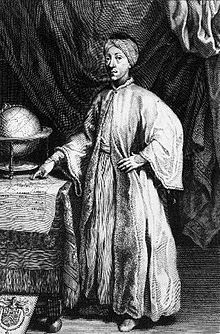Jean de Thévenot
Jean de Thévenot | |
|---|---|
 | |
| Born | 16 June 1633 |
| Died | 28 November 1667 |
| Nationality | French |
| Occupation | Traveller |
Jean de Thévenot (16 June 1633 – 28 November 1667) was a French traveller in the East, who wrote extensively about his journeys. He was also a
Education
He was born in
Early European travels (1652-1655)
Thévenot conceived a desire to travel from reading other travel writing, and his wealth allowed him to fulfill this desire. Leaving France in 1652, he first visited
First travels to the Near and Middle East (1655-1663)
He remained in Constantinople until the following August, and then proceeded to Smyrna, the Greek islands, and finally to Egypt, landing at Alexandria on New Year's Day, 1657. He stayed for a year in Egypt, then visited Sinai, and, upon returning to Cairo, joined the Lent pilgrim caravan to Jerusalem. He visited the chief places of pilgrimage in Palestine, and, after being twice taken by corsairs, got back to Damietta by sea, and was again in Cairo in time to view the opening of the canal on the rise of the Nile (14 August 1658).[1]
In January 1659 he sailed from Alexandria in an English ship, visiting
Further travels (1663-1667)
In November 1663 again sailed for the East, calling at Alexandria and landing at
Here he entered
He was in
Linguistic skills and natural sciences
Thévenot was an accomplished
Travel writing
The account of his first journey was published at Paris in 1665, under the title Relation d’un voyage fait au Levant.
The second and third parts of Thévenot's Voyages were posthumously published from his journals in 1674 and 1684 (all
See also
Notes
References
- This article incorporates text from a publication now in the public domain: Chisholm, Hugh, ed. (1911). "Thévenot, Jean de". Encyclopædia Britannica. Vol. 26 (11th ed.). Cambridge University Press.
- Ratliff, Brandie. "The monastery of Saint Catherine at Mount Sinai and the Christian communities of the Caliphate." Sinaiticus. The bulletin of the Saint Catherine Foundation (2008).
Primary sources
- Thévenot, Jean de. Relation d’un voyage fait au Levant. Paris: L. Billaine, 1665.
- Thévenot's Voyages on Gallica
